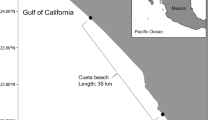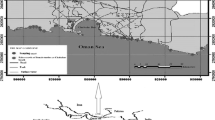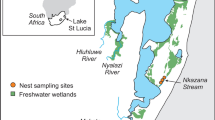Abstract
Trace metals (Cd, Cu, Ni, and Zn) concentrations were assessed in the sea turtle Lepidochelys olivacea from a nesting colony of Oaxaca, Mexico. Twenty-five female turtles were sampled, a total of 250 eggs were collected during the “arribada” event of the 2005–2006 season. Zn concentrations were highest in the yolk [72.3 ± 10.9 μg/g dry weight (dw)] and blood (58.4 ± 4.7 μg/g dw), whereas Ni concentrations were highest in the shell (48.5 ± 12.9 μg/g dw). The mean concentrations of Cu, and Cd in the analyzed tissues were lower than those reported in other sea turtle species. However, Zn and Ni concentrations in the yolk and shell, respectively, had the same distribution pattern observed at loggerhead and green turtles. On the basis of one nesting season, the maternal transfer and/or the excretion rates of trace metals via eggs-laying, estimated in terms of metal burdens in whole body, were 0.2, 7.8, 3.4, and 21.5% for Cd, Cu, Zn, and Ni, respectively.




Similar content being viewed by others
References
Alonso-Aguirre A, Gardner SC, Marsh JC, Delgado SG, Limpus CJ, Nichols WJ (2006) Hazards associated with the consumption of sea turtle meat and eggs: a review for health care workers and the general public. EcoHealth 3:141–153
Baggot JD (1986) Principios de farmacología clínica veterinaria. Editorial Acribia, Zaragoza
Bjorndal KA (1997) Foraging ecology and nutrition of sea turtles. In: Lutz P, Musick JA (eds) The biology of sea turtles. CRC Press, Boca Raton, pp 199–231
Bjorndal K, Bolten A, Bennet R, Jacobson ER, Wronski TJ, Valeski JJ, Eliazar PJ (1998) Age and growth in sea turtles: limitations of skeletochronology for demographic studies. Copeia 1:23–30
Casas-Andreu G (1978) Análisis de la anidación de las tortugas marinas del género Lepidochelys en México. An Cent Cienc Mar Limnol, Universidad Nacional Autónoma de México 5:141–157 (in Spanish)
Day RD, Christopher SJ, Becker PR, Whitaker DW (2005) Monitoring mercury in the loggerhead sea turtle, Caretta caretta. Environ Sci Tech 39:437–446
Eisler R (2006) Mercury hazards to living organisms. CRC Press/Taylor & Francis, Boca Raton
Figler RA, Mackenzie DS, Owens DW, Licht P, Amoss MS (1989) Increased levels of arginine vasotocin and neurophysin during nesting in sea turtles. Gen Comp Endocrinol 73:223–232
Frías-Espericueta MG, Osuna-López JI, Ruiz-Tellez A, Quintero-Alvarez JM, López-López G, Izaguirre-Fierro G, Voltolina D (2006) Heavy metals in the tissues of the sea turtle Lepidochelys olivacea from a nesting site of the northwest coast of Mexico. Bull Environ Contam Toxicol 77:179–185
Gardner SC, Fitzgerald SL, Acosta-Vargas B, Méndez L (2006) Heavy metal accumulation in four species of sea turtles from the Baja California peninsula, Mexico. BioMetals 19:91–99
Godley BJ, Thompson DR, Furness RW (1999) Do heavy metal concentrations pose a threat to marine turtles from the Mediterranean Sea? Mar Pollut Bull 38(6):497–502
Guirlet E, Das K, Girondot M (2008) Maternal transfer of trace elements in leatherback turtles (Dermochelys coriacea) of French Guiana. Aquat Toxicol 88:267–276
Guyton AC (1977) Tratado de fisiología médica. Nueva Editorial Interamericana, México
Hays GC (2001) The implications of adult morphology for clutch size in the flatback turtle (Natator depressa). J Biol Assoc UK 81:1063–1064
IAEA (1987) Intercalibration of analytical methods on marine environmental samples. Trace element measurements on fish homogenate. Results of the Worldwide Intercomparison Run MA-B-3/TM. Report No. 36. IAEA, Monaco
Kampalath R, Gardner SC, Méndez-Rodríguez L, Jay JA (2006) Total and methylmercury in three species of sea turtles of Baja California Sur. Mar Pollut Bull 52:1784–1832
Kaska Y, Furness RW (2001) Heavy metals in marine turtle eggs and hatchlings in the Mediterranean. Zool Middle East 24:127–132
Keen CL, Taubeneck MW, Zidenberg-Cherr S, Daston GP, Rogers JM (1997) Toxicant exposure and trace element metabolism in pregnancy. Environ Toxicol Pharmacol 4:301–308
Kenyon LO, Landry AM, Gill GA (2001) Trace metal concentrations in blood of the kemp’s ridley sea turtle (Lepidochelys kempii). Chelonian Conserv Biol 4:128–135
Kertész V, Fáncsi T (2003) Adverse effects of (surface water pollutants) Cd, Cr and Pb on the embryogenesis of the mallard. Aquat Toxicol 65:425–433
Kertész V, Hlubik I (2002) Plasma ALP activity and blood PCV value changes in chick fetuses due to exposure of the egg to different xenobiotics. Environ Pollut 117:323–327
Kitana N, Callard IP (2008) Effect of cadmium on gonadal development in freshwater turtle (Tracemys scripta, Chrysemys picta) embryos. J Environ Sci Health A 43:262–271
Lam JCW, Tanabe S, Chan SKF, Yuen EKW, Lam MHW, Lam PKS (2004) Trace element residues in tissues of green turtles (Chelonia mydas) from South China waters. Mar Pollut Bull 48:164–192
Lutz P, Musick JA (1997) The biology of sea turtles. CRC Press, Boca Raton
Lutz P, Musick JA, Wyneken J (2003) The biology of sea turtles, vol II. CRC Press, Boca Raton
Maffucci F, Caurant F, Bustamante P, Bentivegna F (2005) Trace element (Cd, Cu, Hg, Se, Zn) accumulation and tissue distribution in loggerhead turtles (Caretta caretta) from the Western Mediterranean Sea (southern Italy). Chemosphere 58:535–542
Márquez MR (1990) FAO species catalogue. Sea Turtle of the world. An annotated and illustrated catalogue of sea turtle species known to date. FAO fisheries synopsis. no. 125, vol 11. FOA, Rome
Márquez MR (1996) Las tortugas marinas y nuestro tiempo. Fondo de Cultura Económica, México
Márquez MR, Villanueva A, Peñaflores C (1976) Sinopsis de datos biológicos sobre la tortuga golfina Lepidochelys olivacea (Eschscholtz, 1829). Instituto Nacional de Pesca, México
Márquez MR, Carrasco MA, Jiménez MC, Peñaflores SC, Bravo GR (2005) Kemp’s and olive ridley sea turtles population status. In: Coyne MS, Clark RD (eds) Proceedings of the twenty-first annual symposium on sea turtle biology and conservation. NOAA technical memorandum NMFS-SEFSC-528, pp 237–239
MESL (1997) Marine Environmental Studies Laboratory, International Atomic Energy Agency, Inorganic Laboratory, Standard Operating Procedures. Monaco
Miller JD (1985) Embryology in marine turtles. In: Gans C, Billet F, Maderson PFA (eds) Biology of the Reptilia. Wiley, New York, pp 269–328
Miller JD (1997) Reproduction in sea turtles. In: Lutz PL, Musick JA (eds) The biology of sea turtles. CRC Press, Boca Raton, pp 51–82
Moody JR, Lindstrom RN (1977) Selection and cleaning of plastic containers for storage of trace element samples. Anal Chem 49:2264–2267
Morreale SJ, Plotkin PT, Shaver DJ, Kalb HJ (2007) Adult migration and habitat utilization. In: Plotkin PT (ed) Biology and conservation of ridley sea turtles. The Johns Hopkins University Press, Baltimore, pp 213–219
Nauen CE (1983) Compilation of legal limits for hazardous substances in fish and fishery products. Food and Agriculture Organization of the United Nations. FAO Fisheries Circular No. 764. FAO, Rome
Ozdilek HG, Ozdilek SY (2007) Impact of corrosive trace elements on sea turtle eggs during embryonic growth. Asian J Chem 19:807–809
Páez-Osuna F, Calderón-Campuzano MF, Soto-Jiménez MF, Ruelas-Inzunza JR (2010) Lead in blood and eggs of the sea turtle, Lepidochelys olivacea, from the Eastern Pacific: concentration, isotopic composition and maternal transfer. Marine Poll Bull 60:433–439
Phillips DJH (1980) Quantitative aquatic biological indicators. Applied Science Publishers, Essex
Rostal DC (2007) Reproductive physiology of the ridley sea turtle. In: Plotkin PT (ed) Biology and conservation of ridley sea turtles. The Johns Hopkins University Press, Baltimore, pp 151–165
Sahoo G, Sahoo RK, Mohanty-Hejmadi P (1996) Distribution of heavy metals in the eggs and hatchlings of olive ridley sea turtle, Lepidochelys olivacea, from Gahirmatha, Orissa. Indian J Mar Sci 25:371–372
Sakai H, Ichihashi H, Suganuma H, Tatsukawa R (1995) Heavy metal monitoring in sea turtles using eggs. Mar Pollut Bull 30(5):347–353
Sakai H, Saeki K, Ichihashi H, Suganuma H, Tanabe S, Tatsukawa R (2000) Species-specific distribution of heavy metals in tissues and organs of loggerhead turtle (Caretta caretta) and green turtle (Chelonia mydas) from Japanese coastal waters. Mar Pollut Bull 40:701–709
Stoneburner DL, Nicora MN, Blood R (1980) Heavy metals in loggerhead sea turtle eggs (Caretta caretta): evidence to support the hypothesis that demes exist in the western Atlantic population. J Herpet 14:171–175
Storelli MM, Marcotrigiano GO (2003) Heavy metal residues in tissues of marine turtles. Mar Pollut Bull 46:397–400
Ward BB, Tuit CB, Jayakumar A, Rich JJ, Moffett J, Wajih S, Naqvi A (2008) Organic carbon, and not copper, controls denitrification in oxygen minimum zones of the ocean. Deep-Sea Res I 55:1672–1683
Zar JH (1999) Biostatistical analysis, 4th edn. Prentice Hall, Englewood Cliffs
Acknowledgments
The authors acknowledge A. L. Páez-Michel (field work), H. Bojórquez-Leyva (laboratory assistance), C. Ramírez-Jáuregui (bibliographic support), G. Ramírez-Reséndiz (statistical analyses), and C. Suárez-Gutiérrez (computing assistance). This research was conducted under permits by Secretaría de Medio Ambiente y Recursos Naturales (SGPA/DGVS/06195).
Author information
Authors and Affiliations
Corresponding author
Rights and permissions
About this article
Cite this article
Páez-Osuna, F., Calderón-Campuzano, M.F., Soto-Jiménez, M.F. et al. Trace Metals (Cd, Cu, Ni, and Zn) in Blood and Eggs of the Sea Turtle Lepidochelys olivacea from a Nesting Colony of Oaxaca, Mexico. Arch Environ Contam Toxicol 59, 632–641 (2010). https://doi.org/10.1007/s00244-010-9516-3
Received:
Accepted:
Published:
Issue Date:
DOI: https://doi.org/10.1007/s00244-010-9516-3




